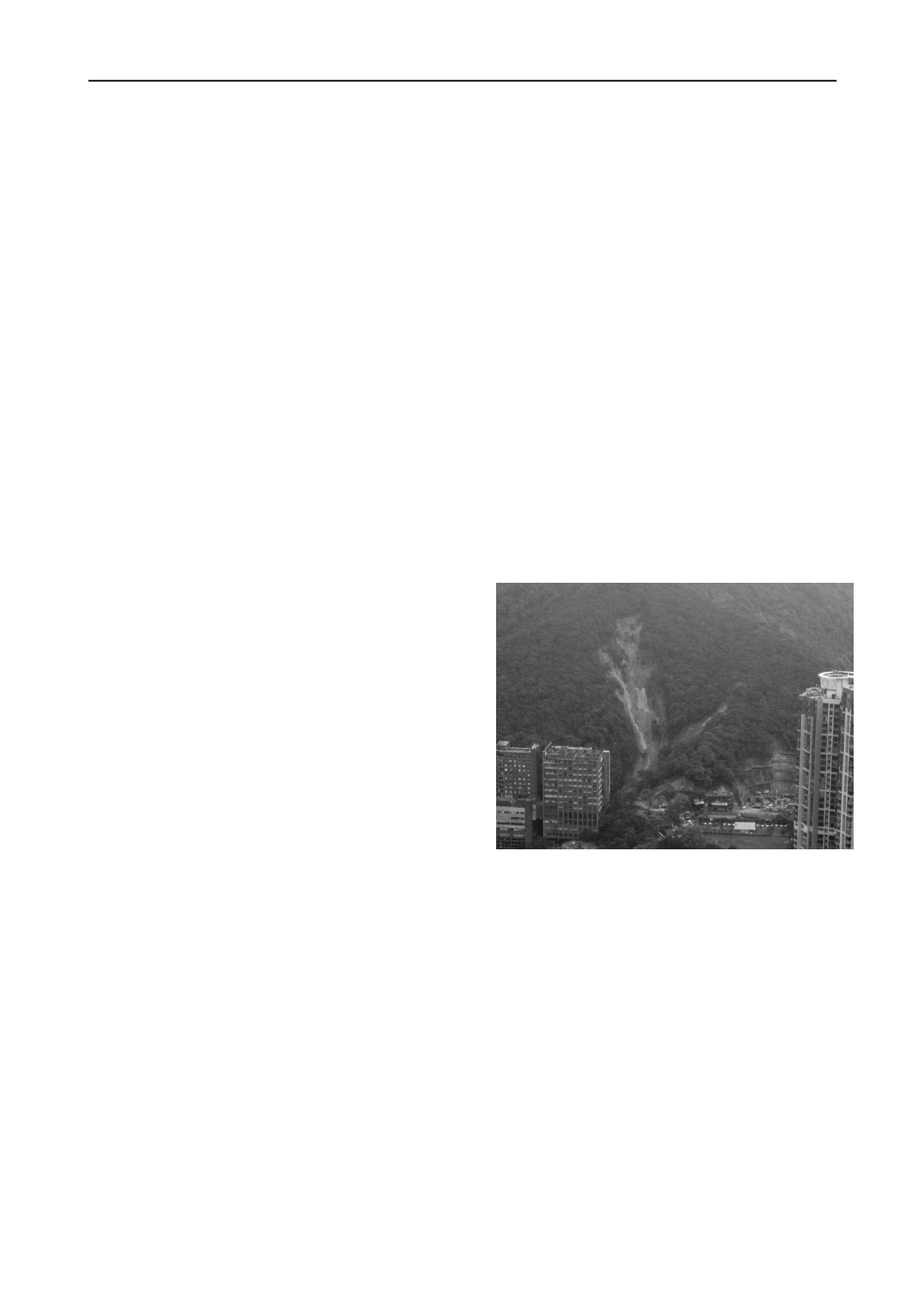
2215
Technical Committee 208 /
Comité technique 208
Furthermore, the landslide investigation findings indicated
that the failed wall was 10 m high but only about 0.8 m thick.
The wall thickness is much less than that indicated in the
record available. This incident highlighted the danger of
slender masonry walls that are liable to fail in a brittle manner
without any prior signs of distress, and the importance of
verifying the wall thickness in stability assessment. This
lesson learnt was incorporated in the guideline for stability
assessment of old masonry walls (GEO 2004a).
7. FILL SLOPES
Following the disastrous failure of a fill slope at Sau Mau
Ping in 1976, the Government appointed an Independent
Review Panel to review the landslide problem and make
recommendations on the design of fill slopes in Hong Kong.
The Panel recommended, amongst others, that the minimum
treatment of existing loose fill slopes should consist of
removing the loose surface soil by excavating to a vertical
depth of not less than 3 m and recompacting to an adequate
standard, together with the provision of subsurface drainage
behind the recompacted fill layer at the toe of the slope.
Technical guidance on the treatment of existing loose fill
slopes is given in relevant manual and technical circular
(GCO 1984, GEO 2004b).
Up to 2012, about 260 loose fill slopes have been
upgraded using the recompaction approach by the GEO.
Between 1997 and 2012, a total of 18 landslides occurred on
recompacted fill slopes. The primary causes of landslides of
these incidents are:
(a) Surface flow concentration
(b) Leakage or bursting of water-carrying services
(c) Inadequate subsurface drainage provisions
Discounting washout failures due to concentrated surface
water flow or leakage of water-carrying services, landslides
on recompacted fill slopes were generally ductile in nature
and did not involve sudden and fast-moving debris as in
liquefaction failure.
Enhancement measures have been implemented with
reference to the lessons learnt from these landslides. For
instance, the Code of Practice on Monitoring and
Maintenance of Water Carrying Services Affecting Slopes,
which was first issued in 1996, has been updated taking into
account lessons learnt from landslides triggered by leakage or
bursting of water-carrying services (ETWB 2006).
Detailing of slope drainage provisions has also been
improved. Areas for improvement include provision of
adequate movement joints for surface drainage channels and
provision of filter pipes at upstream end of the subsurface
drainage blankets behind the recompacted fill etc. The
improvement measures were promulgated in the GEO Report
Nos. 210 and 225 (Hui et al. 2007, Fugro 2008)
8. NATURAL HILLSIDE
Hong Kong has a land areas of about 1,100 km
2
. About 60%
is natural terrain, over 30% of which has a slope gradient over
30
o
. Natural terrain landslides in Hong Kong are mainly rain-
induced. Most of them occurred in remote areas while some
affects developments. The GEO has been undertaking
technical development works based on the study of natural
terrain landslides since the early 1990s.
Based on observed runout distance of landslide debris, a
set of simple and suitably conservative guidelines has been
developed (Wong 2003) for initial screening purposes to
assist planners, land administrators, project managers, etc. to
review whether or not a given site is subject to natural terrain
landslide hazards. Where a site is shown to be potentially
affected by landslide hazards, more refined criteria are then
used to examine whether the proposed development meets the
‘in-principle objection’ criterion (i.e. relocate the proposed
development or amend development layout), or the ‘alert
criteria’ (i.e. carry out natural terrain hazard study and
appropriate mitigation measures as part of the development).
In June 2008, Hong Kong was hit by a severe rainstorm.
The short-duration rainfall intensity had a return period of
about 1,000 years. The rainstorm triggered over 2,400 natural
terrain landslides mainly on Lantau Island. Some of them
affected developed areas and caused significant social
disruption such as evacuation of houses and temporary
closure of road sections. The GEO carried out systematic
studies on some of these landslides. Detailed field mappings
and in-depth landslide investigation provided valuable
insights into the characteristics of natural terrain landslides.
Comparing the June 2008 landslides with past landslide
records revealed that the 2008 landslides seem to ‘cluster’
around old ones. Up to 92% of the 2008 landslides occurred
within 50 m of at least one past landslide, and 80% within two
or more past landslides (Wong 2009). Although further work
is needed to interpret this phenomenon, this sheds light on the
prediction of regions of natural terrain that is more prone to
failure and has implications in the determination of natural
hillsides that warrant priority for the mitigation of landslide
hazards.
Figure 4: Landslide on the hillside behind the Hong Kong University
Detailed landslide investigations on selected June 2008
landslides showed that past failures could have a significant
implication to the scale of the landslides. Past failures could
lead to extensive colluvial accumulations on hillside, which
are susceptible to give rise to a laterally extensive and a much
larger scale failure during heavy rainstorm than those in the
past (Figure 4) (Maunsell 2009). If the debris of previous
failures deposited along the drainage line, it could become
‘entrainable’, giving rise to a larger scale of a channelized
debris flow (CDF) event (Figure 5) (AECOM 2009). In the
2008 rainstorm, significant entrainment was noted in many of
the long runout CDFs with entrainment ratio up to 10 or
higher (the entrainment ratio is the volume of additional
material that has been entrained by a landslide expressed as a
proportion of the source volume). The amount of the pre-
existing 'entrainable' materials in a drainage line is dynamic
and may change significantly after a rainstorm. This
highlights the implications of the deposition of debris from
past failures on occurrence of some large-scale failures in
natural hillsides.


